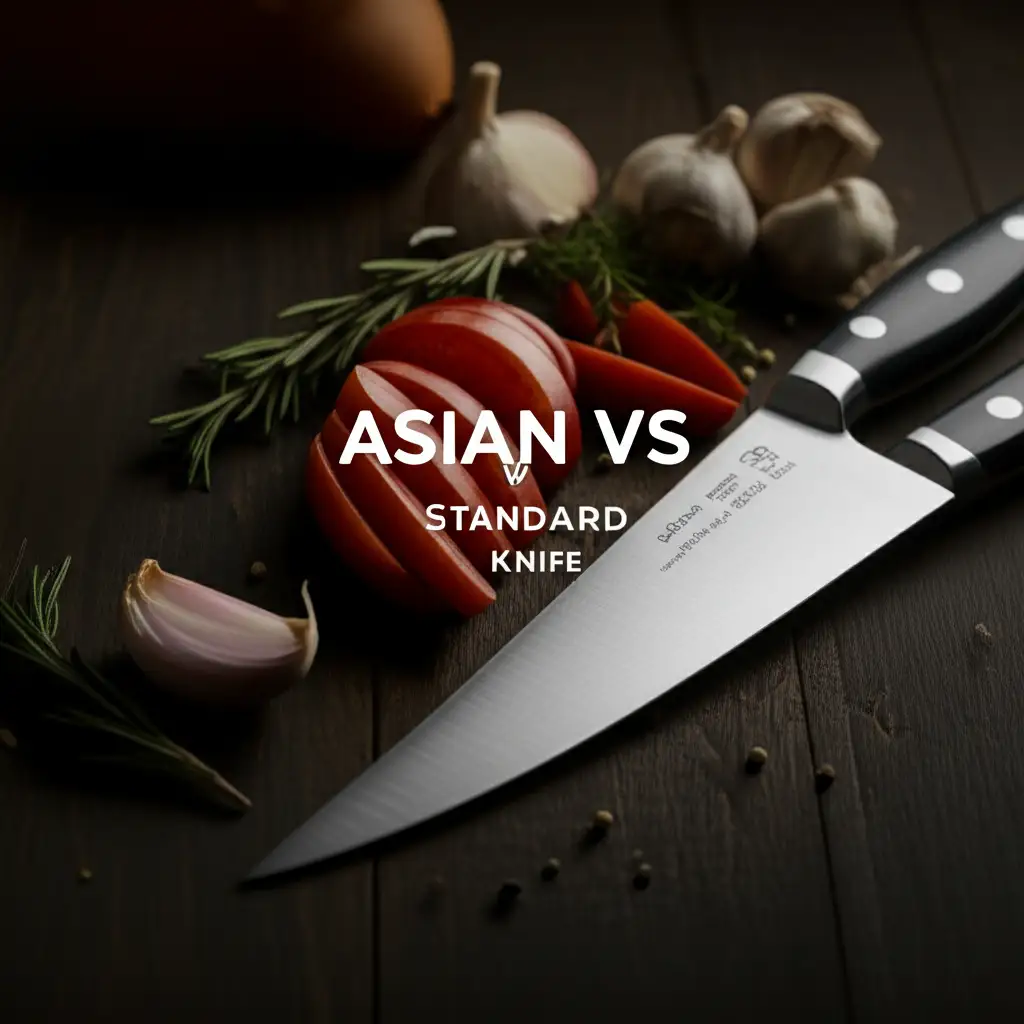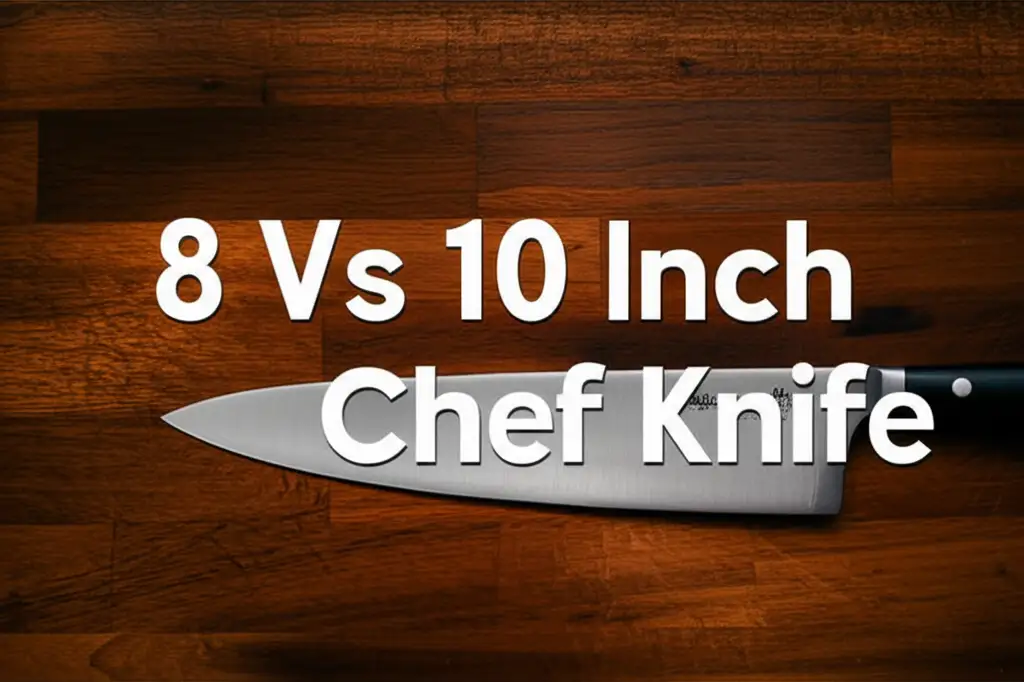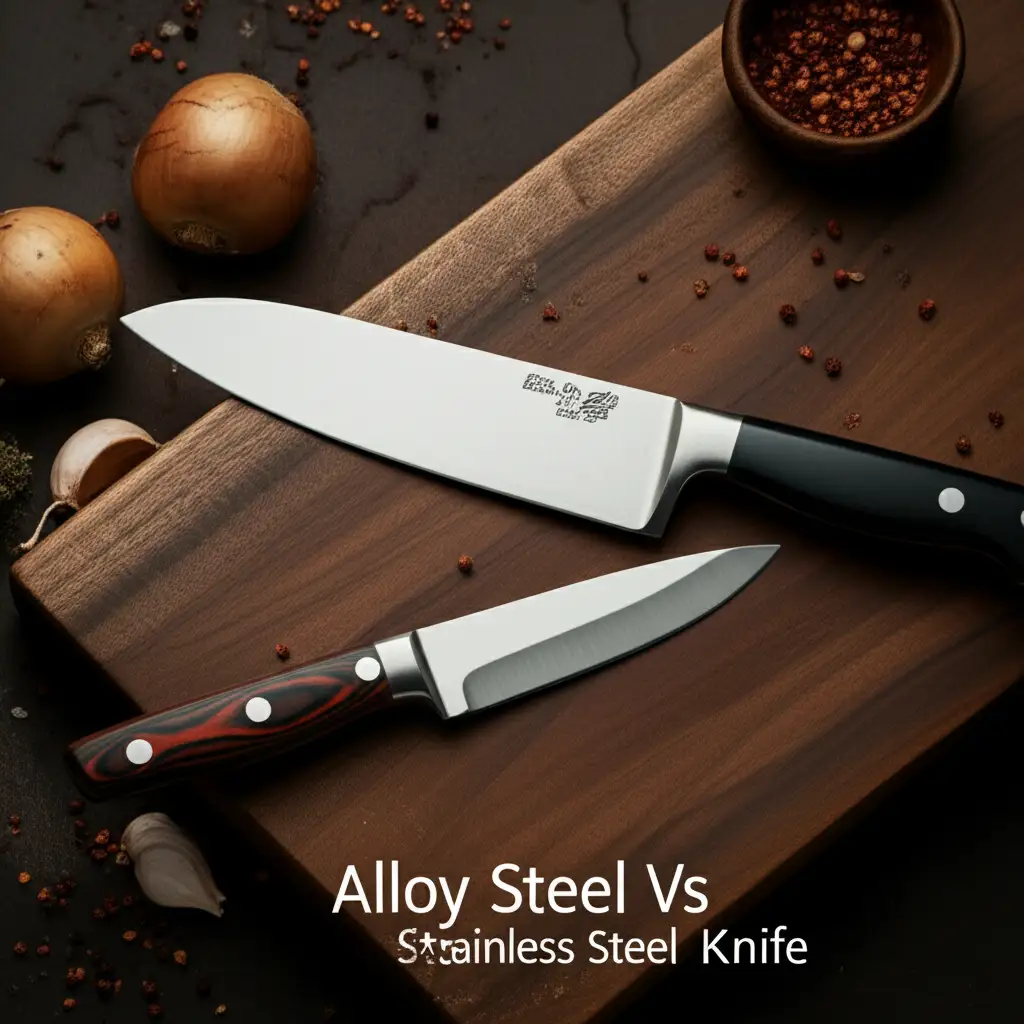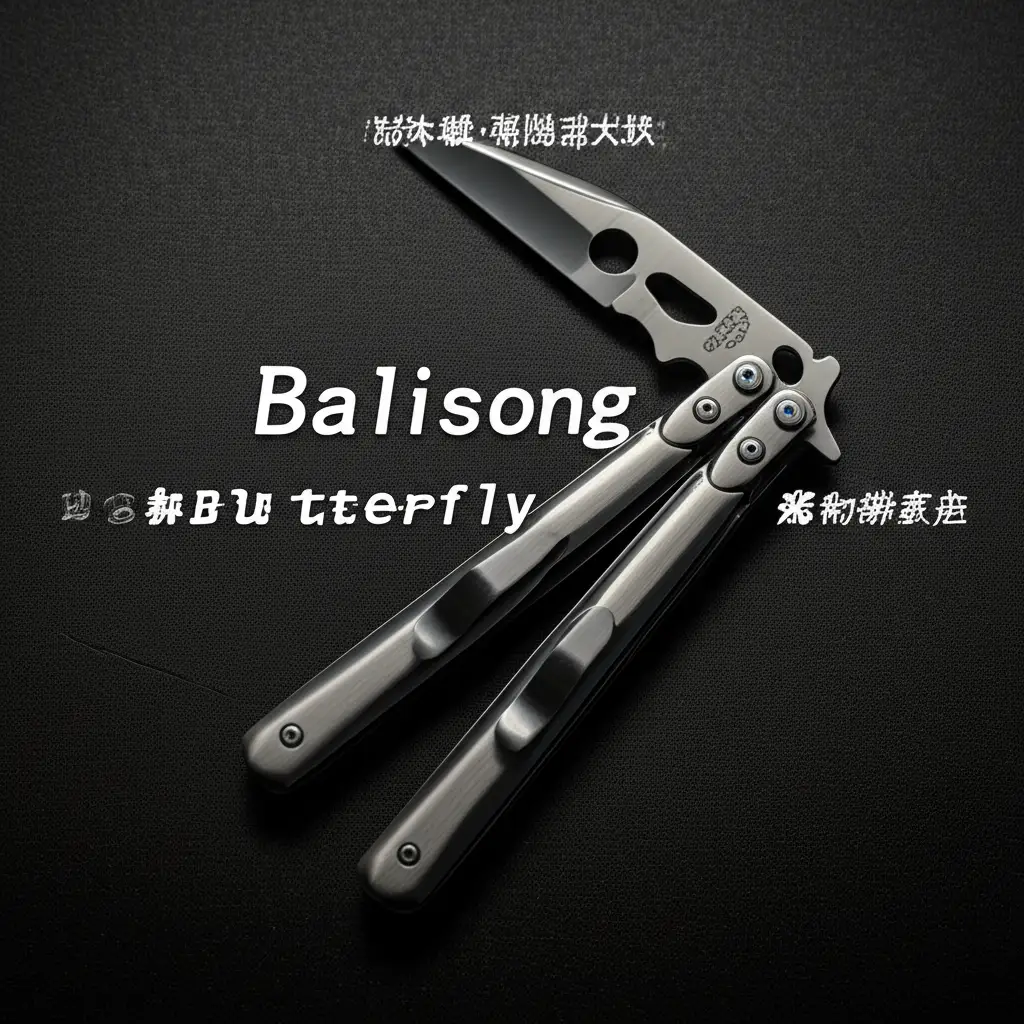· Elira Thomsen · Kitchen Knives · 19 min read
5 Inch Vs 7 Inch Santoku Knife
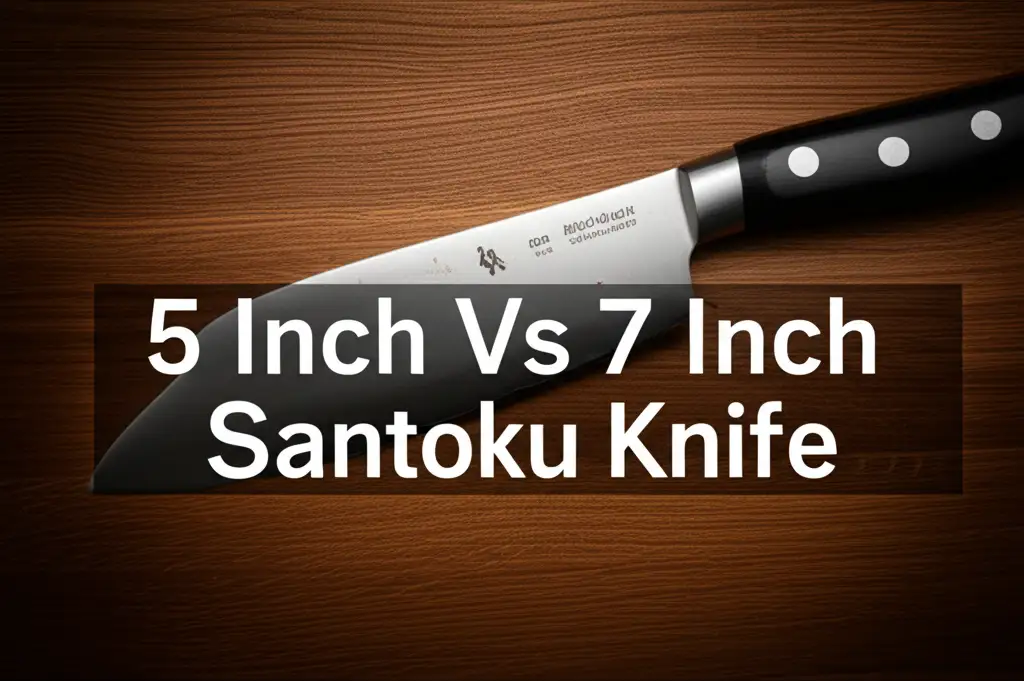
Choosing Your Ideal Santoku: 5 Inch Vs 7 Inch Knife
Have you ever stood in your kitchen, looking at your ingredients, and wondered if your knife is the right tool for the job? For many home cooks, selecting the perfect kitchen knife can feel like a big decision. Today, we are comparing two popular sizes of a versatile blade: the 5 inch vs 7 inch Santoku knife. This guide will help you understand their unique qualities. We will explore which size might best suit your cutting tasks and personal comfort.
Takeaway
- 5-inch Santoku: Excels in precision, detailed tasks, and smaller food items. It is great for limited spaces or smaller hands.
- 7-inch Santoku: Offers versatility for general meal preparation, larger ingredients, and efficient chopping. It is a good choice for standard kitchen work.
- Your Choice Matters: The best Santoku size depends on your specific cutting needs, kitchen space, and hand comfort.
Which Santoku knife size is better: 5 inch or 7 inch?
The ideal Santoku knife size depends entirely on your cooking style and the food you prepare. A 5-inch Santoku offers precision for smaller items, while a 7-inch Santoku handles larger tasks with more efficiency. Both excel in their specific roles. Your comfort and common kitchen tasks will guide your best choice.
Understanding the Santoku Knife
The Santoku knife is a popular kitchen tool. Its name means “three virtues” or “three uses.” This refers to its ability to handle meat, fish, and vegetables well. It is a general-purpose knife, much like a chef’s knife. The Santoku blade often features a flat edge and a blunt sheep’s foot tip. This design allows for a quick, efficient up-and-down chopping motion.
Santoku knives typically have a hollow-ground edge. These are often called Granton edges. They feature indentations along the blade. These indentations create air pockets when cutting. This design prevents food from sticking to the blade. This makes chopping and slicing much smoother. The Santoku is known for its balance and ease of use. It is a favorite among both professional chefs and home cooks.
Choosing the right size Santoku affects how you cook. It impacts your comfort and efficiency. A smaller knife feels different from a larger one. Both have unique benefits based on their blade length. Understanding these differences helps you make an informed decision.
Key Features of a Santoku
A Santoku knife has distinct features that set it apart. Its shape and design are optimized for specific cutting tasks. Understanding these features helps appreciate its utility in the kitchen.
- Blade Shape: The Santoku typically has a straighter edge compared to a curved chef’s knife. This promotes a chopping motion rather than a rock-and-slice. It also features a distinct sheep’s foot tip. This means the spine curves down to meet the edge.
- Granton Edge: Many Santoku knives have hollow-ground indentations. These dimples reduce friction and prevent food from sticking. This is very helpful when slicing moist or starchy foods.
- Balance: Santoku knives are often designed for excellent balance. This makes them comfortable to hold and control. A well-balanced knife reduces hand fatigue during long cutting sessions.
- Versatility: Despite its specialized design, the Santoku is highly versatile. It performs well for dicing, mincing, and slicing. This makes it a go-to knife for many kitchen tasks. It is why it holds its place as a kitchen workhorse.
The size of the Santoku knife influences these features. A smaller blade might make precision easier. A larger blade can cover more ground. We will explore how blade length affects performance.
The Compact Power of a 5-Inch Santoku Knife
A 5-inch Santoku knife is a truly nimble tool in the kitchen. Its shorter blade offers outstanding control and precision. This size is ideal for tasks that require delicate handling. Think of peeling garlic or slicing small fruits. This compact knife shines when detailed work is necessary.
I often reach for my 5-inch Santoku when I am preparing a quick salad. It makes short work of cherry tomatoes and cucumbers. Its size makes it easy to maneuver around small ingredients. This knife is also a fantastic choice for individuals with smaller hands. It feels very comfortable and natural to grip. It provides excellent control without feeling unwieldy.
The 5-inch Santoku knife is also perfect for kitchens with limited counter space. A smaller knife takes up less room. This is a practical benefit for apartment dwellers or compact kitchens. You can easily keep it close at hand. It might even fit better in your knife block or drawer. This small blade is mighty in its capabilities.
Ideal Uses for a 5-Inch Santoku
The 5-inch Santoku is a specialist for many kitchen tasks. It excels where larger knives feel clumsy. Its precision opens up new possibilities in your food preparation.
- Small Produce: This knife handles garlic cloves, shallots, and herbs with ease. It allows for very fine mincing. You can also slice small fruits like strawberries and grapes with perfect control. Its size is perfect for trimming individual vegetables.
- Detailed Work: The 5-inch blade is excellent for intricate tasks. It can be used for scoring meat or filleting small fish. Its short length makes it highly agile for delicate cuts. You can perform precise cuts needed for garnishes.
- Quick Tasks: For slicing a single tomato or an avocado, this knife is quick and efficient. You do not need to pull out a larger knife. It is always ready for those small, spontaneous cutting needs. Its compact size helps when you need to quickly cut something for a snack. For other food preparation tips, you might find information on how to handle produce useful, such as how to clean mushrooms.
- Storage and Mobility: Its small size means it fits well in any knife block. It is also portable for picnics or camping. You can easily transport it without much hassle. This makes it a versatile tool beyond the kitchen.
A 5-inch Santoku is a valuable addition to any knife collection. It fills a niche that larger knives cannot. It brings precision and comfort to your cutting experience.
The Versatile Reach of a 7-Inch Santoku Knife
The 7-inch Santoku knife is often considered the standard size. It offers a balance of control and cutting power. This length makes it incredibly versatile for most daily kitchen tasks. When you need to chop many vegetables or slice larger cuts of meat, the 7-inch blade delivers. It provides ample length to handle bigger ingredients efficiently.
I find my 7-inch Santoku to be my true workhorse for meal prep. It effortlessly glides through onions, carrots, and potatoes. Its longer blade means fewer strokes are needed to cut through wide foods. This saves time and effort during cooking. For those who prepare family meals, this knife is a true asset. It makes large-batch cooking much easier.
A 7-inch Santoku knife is also well-suited for a variety of hand sizes. It offers a good grip and weight for comfortable use. The added length gives a sense of stability. This makes it a confident choice for many home cooks. If you are looking for a go-to knife that can handle most situations, the 7-inch Santoku is an excellent contender. It offers a great blend of reach and precision.
Key Advantages of a 7-Inch Santoku
The 7-inch Santoku is a powerhouse for general cooking. Its benefits extend across a wide range of kitchen activities. This makes it a popular choice for many kitchens.
- General Purpose: This knife handles a broad spectrum of ingredients. It is perfect for chopping vegetables for a stir-fry or dicing potatoes. You can slice through larger fruits like melons with ease. It truly is a versatile tool for everyday cooking.
- Larger Ingredients: Its longer blade is ideal for cutting big items. You can slice roasts or large fish fillets in a single smooth motion. This length prevents awkward or multiple cuts. It ensures clean, even slices on bigger foods.
- Efficiency in Prep: When preparing meals for several people, efficiency is key. The 7-inch Santoku allows you to process more food quickly. Its longer edge means you can chop more at once. This significantly speeds up your cooking process. This makes batch cooking much simpler.
- Comfort for Many: This size provides a good balance for most hand sizes. It is not too long to be unwieldy, nor too short to lack power. It offers a comfortable grip and leverage for various cutting techniques. This makes it suitable for many different users. Many people find this length comfortable for their daily tasks. For other kitchen appliance comparisons that can boost your meal prep efficiency, consider looking into Breville juicer vs Ninja blender.
The 7-inch Santoku knife is a reliable workhorse. It helps you tackle most kitchen tasks with confidence. It offers the best of both worlds: control and significant cutting capacity.
Key Differences in Performance and Application
When comparing a 5 inch vs 7 inch Santoku knife, their performance differs significantly based on size. The blade length impacts everything from cutting technique to food suitability. Understanding these distinctions helps you choose the right tool. It also helps you get the most out of your knife. The weight and balance also shift between the two sizes. This affects how the knife feels in your hand.
A 5-inch Santoku, being shorter, offers more acute control. Its lightweight nature makes it nimble for quick, small cuts. You can perform precise tasks with less effort. It is like driving a sports car in tight turns. Conversely, a 7-inch Santoku provides more blade real estate. This makes it better for longer, more powerful strokes. It handles bulk cutting with greater ease. Think of it as a robust sedan on a highway.
The cutting action itself changes with blade length. The 5-inch knife encourages short, precise chops. This is perfect for mincing herbs or dicing garlic. The 7-inch knife allows for a longer, more fluid motion. This is great for slicing through large vegetables or meat. Your choice should align with the types of food you typically prepare. It should also match the cutting methods you prefer.
Size and Maneuverability
The physical dimensions of a Santoku knife play a critical role in its handling. Blade length directly impacts how easily you can move the knife. This affects your control over the cut.
- 5-inch Santoku: This shorter knife is highly maneuverable. It is excellent for precision work where fine control is necessary. You can easily navigate around bones or perform delicate garnishes. Its smaller profile means less resistance during intricate cuts. It also makes it easier to use in tight spaces on a cutting board.
- 7-inch Santoku: The longer blade of the 7-inch Santoku offers more reach. This is beneficial for chopping through large items. It allows you to cover more area with each stroke. While slightly less nimble than its smaller counterpart, it provides a stable cutting platform. This increased length can be more forgiving for general cutting motions. It offers a better working surface for various foods.
Weight and Balance
The weight and balance of a knife are crucial for comfort and fatigue reduction. These aspects change noticeably between a 5-inch and a 7-inch Santoku.
- 5-inch Santoku: Generally lighter, this knife reduces strain during extended use. Its balance point is often closer to the handle. This enhances fine motor control. The light weight makes quick, repetitive tasks less tiring. It feels very agile in your hand.
- 7-inch Santoku: This knife usually has more heft. The added weight provides a sense of power and stability during cutting. The balance point might be slightly further down the blade. This helps with the momentum needed for larger chopping tasks. The extra weight can assist in powering through denser foods. It offers a robust feel for heavy-duty kitchen work.
Applications and Efficiency
The optimal use for each knife size varies. The efficiency of your cutting tasks depends on matching the knife to the job. This directly affects your overall cooking experience.
- 5-inch Santoku: This knife excels in detail-oriented applications. It is perfect for preparing small quantities or delicate ingredients. You will find it efficient for tasks like mincing ginger or trimming mushrooms. Its precision reduces waste and improves presentation. It simplifies intricate culinary work.
- 7-inch Santoku: This knife is more suited for volume and larger scale preparations. It is highly efficient for chopping large batches of vegetables. It handles bigger cuts of meat with ease. The longer blade allows for a more continuous cutting motion. This speeds up general meal preparation. It helps you process a lot of food quickly.
Factors to Consider When Choosing Your Santoku
Choosing between a 5 inch vs 7 inch Santoku knife is a personal decision. Several factors play a role in finding your perfect kitchen tool. What works for one person might not work for another. Consider your own needs and preferences carefully. Your comfort and common kitchen tasks should guide your choice. This section will help you weigh these important points.
I always tell people to think about how they actually cook. Do you mostly prepare small meals for one or two? Or do you cook for a big family? These everyday habits inform your knife needs. Think about the types of food you buy most often. Are you frequently dicing small garlic cloves? Or are you slicing large roasts and watermelons? The answers to these questions will narrow down your choice significantly.
Consider your kitchen layout too. Is your counter space limited? A smaller knife might be more practical. Do you have plenty of room to maneuver? Then a larger knife might feel more natural. Finally, remember your hand size and comfort. A knife should feel like an extension of your arm, not a burden.
Your Hand Size and Comfort
The size of your hands is a critical factor in knife selection. A comfortable grip is essential for safety and efficiency. An ill-fitting knife can lead to discomfort or even accidents.
- Smaller Hands: If you have smaller hands, a 5-inch Santoku might offer superior comfort. Its shorter handle and lighter weight can feel more natural to grip and control. You will have a better sense of precision. This reduces the effort needed for detailed cuts.
- Larger Hands: Individuals with larger hands may find the 7-inch Santoku more comfortable. Its longer handle provides ample space for a full grip. The added weight often feels more balanced. This allows for a powerful and stable cutting motion. It fills the hand more completely.
- Overall Ergonomics: Beyond hand size, consider how the knife’s handle fits your palm. Some knives have thicker handles, others thinner. Always try to hold the knife if possible. Feel its balance and weight distribution. A well-designed handle will prevent fatigue.
Types of Food You Prepare Most Often
The primary function of your knife is to cut food. So, the kind of food you prepare is a major determinant in your choice. Match the knife’s capabilities to your culinary habits.
- Small and Delicate Foods: If your cooking involves a lot of small vegetables, fruits, or herbs, the 5-inch Santoku is a clear winner. Its precision makes mincing, peeling, and slicing these items easier. It handles individual items with great finesse. This is also ideal for intricate garnishing.
- Large and Bulk Foods: For those who frequently cook for groups or handle large produce, the 7-inch Santoku is more appropriate. It excels at chopping large onions, melons, or breaking down bigger cuts of meat. Its longer blade processes more food quickly. This is efficient for meal prep.
- Mixed Cooking Styles: If your cooking varies greatly, you might find benefit in owning both sizes. The 5-inch for precision, and the 7-inch for general tasks. Or, you could opt for the 7-inch as a versatile all-rounder. Consider which type of task you do most often.
Kitchen Counter Space
Your kitchen layout and available workspace impact your knife choice. A smaller kitchen might benefit from a compact knife. A spacious kitchen offers more flexibility.
- Limited Space: A 5-inch Santoku takes up less room on your cutting board. This is perfect for small apartments or compact kitchen setups. It allows you to work efficiently even in tight areas. You will feel less cramped while preparing food.
- Ample Space: If you have generous counter space, a 7-inch Santoku fits perfectly. Its length does not hinder movement. You can enjoy the full range of motion it offers. This allows for comfortable and expansive cutting.
- Storage: Consider where you will store your knife. A 5-inch Santoku fits easily into most knife blocks or drawers. A 7-inch might require specific slots. Think about your existing knife storage solutions. A well-organized kitchen helps keep your cooking smooth. Maintaining a clean and organized kitchen also helps. You might find tips on how to clean your refrigerator useful for overall kitchen hygiene.
Personal Preference and Cutting Style
Ultimately, your personal preference and how you cut food matter most. Some people prefer a lighter knife, others a heavier one. Your cutting technique also influences the ideal blade.
- Precision vs. Power: Do you prefer delicate, controlled cuts, or powerful, efficient chops? The 5-inch is for precision, the 7-inch for power. Your natural cutting rhythm should align with the knife’s design.
- Feel of the Knife: Hold both sizes if possible. What feels right in your hand? Does one feel more balanced or natural? The “feel” of a knife is subjective but very important for long-term satisfaction.
- Cutting Technique: If you prefer a quick, up-and-down chopping motion, both Santoku sizes work well. However, the 7-inch provides more length for a consistent rhythm on larger items. The 5-inch allows for more minute adjustments.
Choosing the right Santoku knife is an investment in your cooking comfort. Think through these factors. They will lead you to the best decision for your kitchen.
Maintenance and Care for Your Santoku Knife
Proper care ensures your Santoku knife lasts for years. It also keeps its edge sharp and safe. Whether you choose a 5 inch vs 7 inch Santoku knife, the maintenance principles are the same. A well-cared-for knife performs better and reduces the risk of accidents. Neglecting your knife can lead to dullness, rust, or even damage. This section will cover essential care tips.
I always wash my knives by hand immediately after use. This simple habit prevents food acids from damaging the blade. It also keeps the knife sanitary. Dishwashers are generally not good for knives. The harsh detergents and high heat can dull the blade and damage the handle. They can also cause the blade to chip or warp. Hand washing is gentle and effective.
Drying your knife immediately after washing is also crucial. Air drying can lead to water spots or rust. A clean, dry towel works best. Once dry, store your knife properly to protect the blade. This prevents it from hitting other utensils. Correct storage keeps the edge sharp and safe.
Washing Your Santoku Knife
Hand washing is the best way to clean your Santoku knife. It protects the blade and keeps it sharp. This method ensures your knife remains in top condition.
- Immediate Wash: Wash your knife right after each use. Food acids can stain or corrode the blade if left on too long. This also prevents food from drying onto the surface.
- Warm, Soapy Water: Use warm water and mild dish soap. Gently clean the blade and handle with a soft sponge or cloth. Avoid abrasive scrubbers. They can scratch the blade finish.
- Avoid Dishwashers: Never put your Santoku knife in the dishwasher. The extreme heat, harsh detergents, and jostling can damage the blade. They can also weaken the handle material. Dishwashers quickly dull a knife’s sharp edge.
Drying and Storage
Proper drying and storage are vital for blade longevity. They prevent rust and keep the edge protected. These steps ensure your knife stays ready for use.
- Immediate Drying: Always dry your knife immediately after washing. Use a clean, soft towel. This prevents water spots and rust formation. Ensure the blade is completely dry before storing.
- Safe Storage: Store your Santoku knife in a way that protects its edge. Options include a knife block, magnetic strip, or an in-drawer knife tray. Do not store it loosely in a drawer. This can dull the blade and create a safety hazard. Protecting the edge is key for sharpness.
- Blade Protection: If using a knife roll or sheath, ensure it is clean and dry. This further protects the blade from moisture and damage. Proper storage extends the life of your knife.
Sharpening and Honing
Sharpening and honing are different processes, but both are important. They maintain your knife’s cutting performance. Regular attention keeps your blade in prime condition.
- Honing: Use a honing steel frequently, perhaps before each use. A honing steel straightens the blade’s microscopic edge. It does not remove metal. This keeps the knife feeling sharp between true sharpenings. It maintains the blade’s alignment.
- Sharpening: Sharpen your Santoku knife when it no longer cuts cleanly. This might be every few months depending on use. Use a whetstone, pull-through sharpener, or send it to a professional. Sharpening removes a small amount of metal to create a new, keen edge. A sharp knife is a safe knife.
- Angle: Most Santoku knives have a sharper blade angle than Western chef’s knives, often around 15 degrees per side. Maintain this angle when sharpening for optimal performance. Consistent sharpening ensures optimal cutting.
Proper care extends the life and performance of your Santoku knife. By following these simple steps, your 5 inch or 7 inch Santoku knife will serve you well for many years of cooking.
Is One Better? Finding Your Perfect Santoku Match
When we talk about a 5 inch vs 7 inch Santoku knife, it’s not about which one is inherently “better.” Instead, it’s about which one is better for you. Each size offers distinct advantages that cater to different cooking styles and preferences. The “best” Santoku knife is the one that feels most comfortable and efficient in your hands for the tasks you perform most often. This personal fit is the most important factor to consider.
I’ve learned that a great knife can transform your cooking experience. It makes prep work enjoyable instead of a chore. So, my goal for you is to find that perfect fit. Think about your everyday kitchen routines. Do you often find yourself needing precision for small ingredients? Or do you frequently tackle large batches of vegetables and bigger cuts of meat? Your answers will point you toward the ideal size.
Ultimately, your choice is an investment in your culinary journey. A knife that feels right promotes better technique and safer cutting. It brings joy to your time in the kitchen. So, take the time to consider your needs carefully.
Assessing Your Kitchen Needs
Think about the usual tasks you perform in your kitchen. This is the first step in deciding between a 5-inch and a


